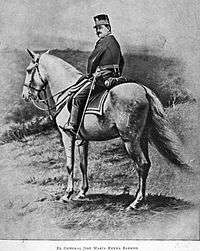José María Reina Barrios
José María Reyna Barrios (24 December 1854 – 8 February 1898) was President of Guatemala from 15 March 1892 until his death on 8 February 1898. He was born in San Marcos, Guatemala and was nicknamed Reynita, the diminutive form, because of his short stature.
His Excellency General of Division José María de Jesús Reina Barrios | |
|---|---|
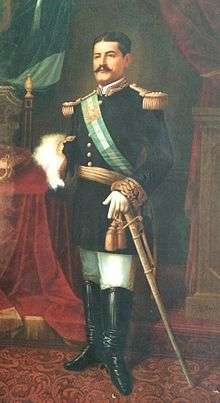 General José María Reina Barrios Museo Nacional de Historia de Guatemala | |
| 15th President of Guatemala | |
| In office March 15, 1892 – February 8, 1898 | |
| Preceded by | Manuel Lisandro Barillas Bercián |
| Succeeded by | Manuel Estrada Cabrera |
| Personal details | |
| Born | 24 December 1854 San Marcos, Guatemala |
| Died | 8 February 1898 (aged 43) |
| Political party | Liberal |
| Spouse(s) | Argelia Benton |
| Children | He did not have any children with Argelia Benton; but he did have five children out of wedlock, among them Joaquín and José.[lower-alpha 1] |
| Parents | Joaquín Reina[lower-alpha 2] Celia Barrios de Reyna |
| Residence | Guatemala City |
| Alma mater | Escuela Politécnica |
| Occupation | Military |
| Signature | |
| Nickname(s) | "Reinita" "Don Chemita" "Tachuela" "Man of the tragic eights"[lower-alpha 3] |
He was a moderate of Guatemala's Liberal Party, who worked to solidify the less controversial of the reforms of late president Justo Rufino Barrios.
Political Life
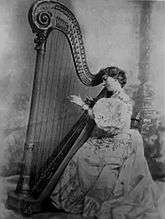
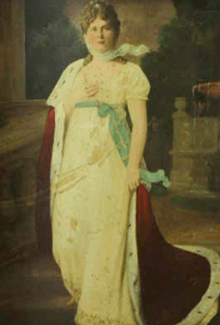
Reyna Barrios was nephew of Justo Rufino Barrios, and as such he started his political career while his uncle was still President of Guatemala. After Barrios sudden death in Chalchuapa, El Salvador on April 2. 1885, Reyna Barrios increased his political activity under the government of Manuel Lisandro Barillas, who was jealous of his popularity and sent him to Europe under false pretenses that there was a diplomatic appointment for him. The appointment never materialized and Reina Barrios was stuck in Europe and then in the United States for a few years.[2]
1892 Presidential elections
Reyna Barrios finally made it back to Guatemala, in time to run for office in the 1892 presidential elections. It was the first election in Guatemala that allowed the candidates to advertise in the local newspapers. [3] The candidates who ran for office were:
| Name | Party | Supported by: | Other information |
|---|---|---|---|
| Lorenzo Montúfar | Liberal | Liberal Club | 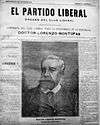 |
| Francisco Lainfiesta | Liberal | None | Published his government proposal in the Diario de Centro America, taking advantage of the freedom of the Press that existed during Barillas' government. |
| José María Reyna Barrios | Liberal | Liberal Club | Eventual winner. |
| Miguel Enríquez | Conservative | Conservative Party | Enríquez had been a liberal, but became a conservative after the persecution that he suffered from the Barillas administration.[lower-alpha 4] |
| José Carranza Llerena | Conservative | None | Medical Staff of President Barillas. |
Barillas Bercian was unique among all liberal presidents of Guatemala between 1871 and 1944: he handed over power to his successor peacefully. When election time approached, he sent for the three Liberal candidates to ask them what their government plan would be. The following anecdote recounts better what happened then:[5]
First arrived lawyer Francisco Lainfiesta, and General Barillas, with the friendliest of smiles, said: "Mr. Lainfiesta: you are one of the candidates in the upcoming elections and perhaps the more likely to win. Therefore, I would like to know what your attitude and your political system of government will be, if you get to win. Especially, I would like to know your attitude about my person; because I have made my mistakes, I do not deny it. I was a simple worker at my carpentry when General Justo Rufino Barrios sent for me to be appointed second presidential designate. I would therefore, Mr. Lainfiesta, know what conduct you will observe towards me." Mr. Lainfiesta said: "General Barillas: if luck would favor me with the election victory, my government will be based on strict adherence to the Constitution; the law would be the law and anyone who has acquired some responsibility, will have to answer for it before the relevant courts. A firm and righteous compliance with the constitutional provisions shall be the standard of my conduct as president". "Very well" said general Barillas, and both parted cordially.
Barillas then brought in Dr. Montúfar and interrogated him in the same or similar way as he had done Mr. Lainfiesta. Dr. Montúfar responded in similar terms as Lainfiesta, stressing his claims to obedience of the Constitution and strict enforcement.
Finally general Reyna Barrios came in; when in the midst of pleasant conversation, General Barillas repeated his question, and Reyna replied, with a sincere smile: "We should not even talk about that, general; because you and I are the same. Rest assured that I will know how to respect and protect you." And then both shook hands with effusion.[5] By the election period, the first two days of voting favored Lainfiesta. But by the third day, a huge column of Quetzaltenango and Totonicapán Indigenous people came down from the mountains to vote for general Reyna Barrios. The official agents did their job: Reyna was elected president[7] and, not to offend the losing candidates, Barillas gave them checks to cover the costs of their presidential campaigns. Reyna Barrios, of course, received nothing, but he went on to become President on March 15, 1892.[8]
Government
During Barrrios's first term in office, the power of the landowners over the rural peasantry increased. He oversaw the rebuilding of parts of Guatemala City on a grander scale, with wide, Parisian style avenues built. He oversaw Guatemala hosting the first "Exposición Centroamericana" ("Central American Fair") in 1897. During his second term, Barrios printed bonds to fund his ambitious plans, fuelling monetary inflation and the rise of popular opposition to his regime.
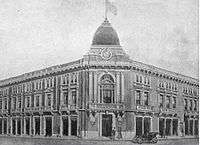
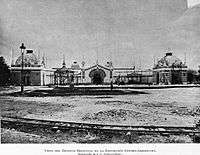

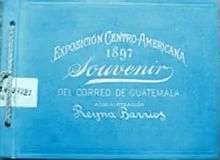
Infrastructure

As part of the efforts for the Central American Expo, his government embellished the city with avenues and monuments following Parisian style and built the Northern Railroad of Guatemala. Due to the 1917-1918 earthquakes most of these structures were lost.[11]
His administration also work on improving the roads, installing national and international telegraphs and introducing electricity to Guatemala City. Completing a transoceanic railway was a main objective of his government, with a goal to attract international investors at a time when the Panama Canal was not built yet.
Buildings and monuments built during Reyna Barrios administration
| Monument | Image | After 1917-1918 | Location | Description |
|---|---|---|---|---|
| Plaza de Armas -Central Square- remodeling |   |
  |
Guatemala City Center | As part of the Central America Fair, Reyna Barrios ordered a series of monument and building constructions. Among them, he remodeled Central Square, removing the old Spanish Fountain and adding an elegant iron fence to the area. |
| Presidential Palace |   |
 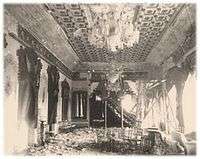 |
Plaza de Armas -Central Square- | Reyna Barrios hired Spaniard architect José de Bustamante, to build his Presidencial Palace. The contract was approved on February 8, 1895 and the structure was built in a garden of the old Spanish Royal Palace. It cost around 400,000 pesos; construction began on January 1, 1895 and the Palace was opened to the public on December 24, 1896.[12] It was the headquarters for the Government executive branch during Reyna Barrios and Manuel Estrada Cabrera administrations, until it was destroyed by the 1917-1918 earthquakes. |
| "30 de junio" boulevard |  |
 |
Extension towards the south of Guatemala City. | Avenue built in honor of the Liberal Reform from 1871. Several monuments, palaces and halls were built along the road. Only some statues survived the earthquakes of 1917-18. |
| "La Reforma" Palace and Museum |   |
 |
"30 de junio" boulevard | Located at the end of the "30 de junio" boulevard, this palace and museum was a favorite place for tourists and nationals alike, until it was destroyed by the 1917-18 earthquakes. In its place, later a monument to the Independence was built. |
| Central American Fair Hall |  |
N/A | "30 de junio" boulevard | Built for the Central American Fair of 1897. |
| Registro de la Propiedad Inmueble | N/A |  |
Old plaza of Guatemala City | Originally built for the Real Estate Record office, it was one of the very few buildings that survived the 1917-18 earthquakes. Later, it was transformed into the National History Museum. |
| Escuela Agrícola de Indígenas |  |
 |
"La Aurora" city park | This agriculture school was in the "La Aurora" city park. Later, it was used for the Male Normal School, but was destroyed by the 1917-1918 earthquakes. |
Death
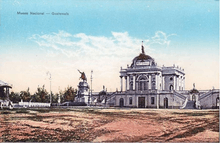
José María Reina was assassinated on 8 February 1898 in Ciudad de Guatemala,[13] by Edgar Zollinger, a British citizen of Swiss stock, shortly after his reelection. Reina Barrios, who was interred in the Metropolitan Cathedral, was succeeded as President by Manuel Estrada Cabrera.
See also



- Exposición Centroamericana
- History of Guatemala
- Northern Railroad of Guatemala
- Manuel Estrada Cabrera
Notes and references
Notes
- Castellanos (2007). "José María Reina Barrios" (in Spanish). Guatemala.
Consuelo Reina Barrios was indeed daughter of Mrs. Argelia Benton a carried the Reina Barrios last name; however, in reality, she was the daughter of general Salvador Toledo, Reina Barrios Chief of Staff.
Missing or empty|url=(help) - La Ilustración Guatemalteca (1897). "Doña Celia Barrios de Reina" (in Spanish). 1 (21). Guatemala.
Celia Barrios was Justo Rufino Barrios' sister.
Cite journal requires|journal=(help) - Gaitán, Héctor (1982). La calle donde tú vives (in Spanish). Guatemala.
He was call "Man of the tragic eights" since he was murdered at 8 pm on February 8, 1898.
- Castellanos (2014). "José María Reina Barrios". Guatemala.
In fact, after the elections Miguel Enríquez had to run away from his farm in Salama after being accused of sedition; he was captured and executed near Zacapa.
Missing or empty|url=(help)
References
- Valdeavellano 1896, p. 10.
- Hernández De León 1930.
- Castellanos 2014, p. 40:00.
- Castellanos 2014, p. 40: 00.
- De Los Rios 1948, p. 78.
- Valdeavellano 1896, p. 24.
- De Los Rios 1948, p. 82.
- De Los Rios 1948, p. 79.
- Castellanos 2014, p. 6:00.
- Valdeavellano 1896, p. 125.
- Hernández de León & 22 de abril de 1959.
- Álvarez Arévalo 2015.
- Hammerton, J. A., ed. (2007). Peoples of All Nations, Volume 7. Concept Publishing Company. p. 2556. ISBN 9788172681449.
Bibliography
- Castellanos, Lorena (2014). "Vida y obra de José María Reyna Barrios". Francisco Marroquín University (in Spanish). Guatemala. Retrieved 3 November 2014.CS1 maint: ref=harv (link)
- De los Ríos, Efraín (1948). Ombres contra Hombres (in Spanish) (2nd ed.). México: Fondo de la Cultura de la Universidad de México.CS1 maint: ref=harv (link)
- Fernández Alfaro, Joaquin Alberto (2014). El Canciller Montúfar (in Spanish) (1st. ed.). San José, Costa Rica: Instituto Manuel María de Peralta, Ministerio de Relaciones Exteriores y Culto de Costa Rica. p. 384.CS1 maint: ref=harv (link)
- Hernández de León, Federico (1959). "El capitulo de las efemerides". La Hora (in Spanish). Guatemala.CS1 maint: ref=harv (link)
- — (1930). El libro de las efemerides (in Spanish). Volumen 3. Guatemala: Tipografia Sanchez y de Guise.CS1 maint: ref=harv (link)
- La Ilustración Española y Americana (1876). "Doctor don Lorenzo Montúfar y Rivera, Ministro plenipotenciario de Guatemala en Madrid". Fundación Joaquín Díaz (in Spanish). 20 (79).CS1 maint: ref=harv (link)
- Luján Muñoz, J. (2003). Las Revoluciones de 1897, La Muerte de J. M. Reina Barrios y la Elección de M. Estrada Cabrera (in Spanish). Guatemala: Artemis & Edinter. ISBN 9788489766990.CS1 maint: ref=harv (link)
- Mendoza, Juan Manuel (1946). Enrique Gómez Carrillo: estudio crítico-biográfico; su vida, su obra y su época (in Spanish) (2nd. ed.). Guatemala: Tipografía Nacional.CS1 maint: ref=harv (link)
- Montufar, Lorenzo (1893). "Notions of international law and laws of war, for the Central American armies". archive.org.CS1 maint: ref=harv (link)
- Valdeavellano, Alberto G. (1896). "Fotografías de la Ilustración Guatemalteca". La Ilustración Guatemalteca (in Spanish). Guatemala: Síguere, Guirola & Cía. I (1–13).CS1 maint: ref=harv (link)
External links

| Preceded by Manuel Lisandro Barillas Bercián |
President of Guatemala 1892–1898 |
Succeeded by Manuel Estrada Cabrera |
